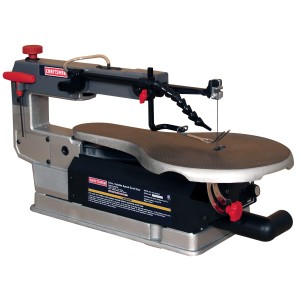Scroll saws are a special addition into a woodworkers “arsenal.” They are small, portable and the best at what they do—bevels, tight turns and even fully enclosed cut-outs. But, not every scroll saw is created equal.
If you want to know how the Craftsman 16 in. stacks up against other entry-to-mid level saws, this review will answer those questions, and give some answers as to why other saws may be asking too much for too little. There is a lot of competition for the low-priced scroll saw space. Brands like Ryobi, Dewalt, Delta, Black & Decker, Dremel and Skil are all producing 16 in. saws for beginner woodworkers; and all have some competitive prices.
Prices vary greatly, however the Craftsman 16 inch is available on Amazon at a really great price for its features.
Why the Craftsman?
The Craftsman is feature-packed, making it a great balance between features and price. The saw has the modern parallel-arm assembly, cast-iron table and base, tilt, bellows, variable speed and a dust port. Here is a little break down of its more notable features.
Most scroll saws use a parallelogram-shaped blade assembly. The Craftsman is no different, utilizing the parallel-arm system. This assembly has fewer parts than the parallel-link assembly (which actually reduces vibration even more). Regardless, the shape of the Craftsman system does reduce vibrations fairly well, and makes blade changes simpler.
Of course, the cast-iron table makes your woodworking quieter. Have you ever heard the expression, “mass is everything in a good saw”? Well, it’s not totally off-base. At 38 lbs., the Craftsman is heavy enough to make your woodworking quieter and more stable.
The work table comes with the standard tilting work table. The Craftsman offers 45 degrees of left-tilt. At 45 degrees, the saw can cut through 1 inch of material. Flat, the saw can cut through 2 inches. The only downside is that the saw doesn’t offer right-tilt as well. Think about it—your bevel cuts are twice as hard with only half the tilt. This is a preference every wood worker should consider. If your woodworking requires 45 degrees of tilt—left and right—then this saw may not be right for you.
The arm-driven bellows helps you keep the work space clear of debris. You can direct it almost anywhere as it’s made up of movable links. The saw also includes a dust port if you want to attach your shop vacuum for sawdust removal.
Variable speed scrolls are ideal for a wide range of jobs. Soft or hard woods, some plastics and even some soft metals can be cut. This saw has a stroke-per-minute range from 400 to 1600. With a changeable blade (standard 5-inch pin and plain-end blades), this saw is more than enough for many materials on many jobs.
Why not the expensive saws?
Ask yourself if you need the “extras” enough to pay twice as much for the saw. Well, if you need what the Craftsman lacks, then maybe paying a little more is best for you. For example, Dewalt’s 20 inch variable speed Scroll has 150 more SPMs, weighs almost 20 pounds more than this saw, has the 45 degrees of left and right tilt, and also has a double parallel-link design which does a lot to decrease noise and vibrations.
The saw also costs twice as much. With only 150 extra strokes-per-minute, the Dewalt only has the right tilt, and some more mass; but the Craftsman will offer reduced vibration if you attach it to your bench. The last question is whether your specific work requires the left and right pitch.
Why not the cheaper saws?
Cheaper models (e.g., Ryobi 16 in. or the Wen 1.2 amp) are lighter. Typically, they have cast-aluminum tables and struggle to reduce vibration and noise. The Craftsman 16 in., on the other hand, has a cast iron table and base taking its weight up to almost 38 lbs. The Ryobi is 8 lbs lighter. Reduced vibration matters. A shaky machine makes shaky cuts!
The cheaper model, interestingly, fails to get down to 400 SPMs by 150 strokes. The differences between strokes-per-minute can make a difference when trying to cut different materials with one saw. But it is up to you to decide about these transient 150 SPMs.
How does the saw compare in terms of price? Here are some similar models for comparison.
DEWALT 20 in. Variable-Speed Scroll Saw
Delta 20 in. Variable Speed Scroll Saw
Genesis 1.2 Amp 16 in. Variable Speed Scroll Saw
Rockwell 16in. Variable Speed Scroll Saw
Skil 3335-07 1.2 Amp 16 in Scroll Saw on Amazon.com
Craftsmans 16 in. Variable Speed Scroll Saw on Amazon.com
Ryobi 16 in. Corded Scroll Saw
WEN 1.2 Amp 16 in. Variable Speed Scroll Saw
Pros
Bench Mounting
Adjustable Bellows to clear cut line
Saw Dust Collection Port
Accepts both pin-end and plain-end 5” length blades (variable thicknesses and widths)
Variable Speed Dial
Cons
Single parallel-link design
Hardware can sustain damage
Left-tilt only
The Craftsman is a great saw. It does offer more to reduce vibration than the cheaper models; and the expensive saws may offer “too much” for your specific work. Hopefully this review helps you make the right decision for your shop.
Good luck getting started with your woodworking! If this was enough, you can buy from Amazon here. You can also view a comparison table of all the top saws by clicking here.
And don’t forget to sign up for our mailing list, you don’t want to miss out on hot reviews and industry insights!
